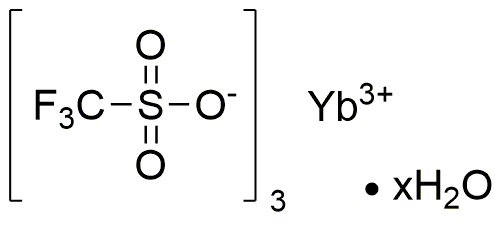Ytterbium(III) trifluoromethanesulfonate hydrate is widely utilized in research focused on:
- Optical Materials: This compound is used in the development of advanced optical materials, particularly in laser technology, where it enhances the performance of solid-state lasers.
- Medical Imaging: Its unique properties make it valuable in the field of medical imaging, especially in MRI contrast agents, improving the clarity and detail of images.
- Nanotechnology: Researchers employ this chemical in the synthesis of nanomaterials, which are crucial for various applications, including drug delivery systems and sensors.
- Electronics: It plays a role in the production of high-performance electronic components, contributing to the miniaturization and efficiency of devices.
- Catalysis: The compound is also explored as a catalyst in chemical reactions, offering advantages in reaction rates and selectivity compared to traditional catalysts.
General Information
Properties
Safety and Regulations
Applications
Ytterbium(III) trifluoromethanesulfonate hydrate is widely utilized in research focused on:
- Optical Materials: This compound is used in the development of advanced optical materials, particularly in laser technology, where it enhances the performance of solid-state lasers.
- Medical Imaging: Its unique properties make it valuable in the field of medical imaging, especially in MRI contrast agents, improving the clarity and detail of images.
- Nanotechnology: Researchers employ this chemical in the synthesis of nanomaterials, which are crucial for various applications, including drug delivery systems and sensors.
- Electronics: It plays a role in the production of high-performance electronic components, contributing to the miniaturization and efficiency of devices.
- Catalysis: The compound is also explored as a catalyst in chemical reactions, offering advantages in reaction rates and selectivity compared to traditional catalysts.
Documents
Safety Data Sheets (SDS)
The SDS provides comprehensive safety information on handling, storage, and disposal of the product.
Product Specification (PS)
The PS provides a comprehensive breakdown of the product’s properties, including chemical composition, physical state, purity, and storage requirements. It also details acceptable quality ranges and the product's intended applications.
Certificates of Analysis (COA)
Search for Certificates of Analysis (COA) by entering the products Lot Number. Lot and Batch Numbers can be found on a product’s label following the words ‘Lot’ or ‘Batch’.
*Catalog Number
*Lot Number
Certificates Of Origin (COO)
This COO confirms the country where the product was manufactured, and also details the materials and components used in it and whether it is derived from natural, synthetic, or other specific sources. This certificate may be required for customs, trade, and regulatory compliance.
*Catalog Number
*Lot Number
Safety Data Sheets (SDS)
The SDS provides comprehensive safety information on handling, storage, and disposal of the product.
DownloadProduct Specification (PS)
The PS provides a comprehensive breakdown of the product’s properties, including chemical composition, physical state, purity, and storage requirements. It also details acceptable quality ranges and the product's intended applications.
DownloadCertificates of Analysis (COA)
Search for Certificates of Analysis (COA) by entering the products Lot Number. Lot and Batch Numbers can be found on a product’s label following the words ‘Lot’ or ‘Batch’.
*Catalog Number
*Lot Number
Certificates Of Origin (COO)
This COO confirms the country where the product was manufactured, and also details the materials and components used in it and whether it is derived from natural, synthetic, or other specific sources. This certificate may be required for customs, trade, and regulatory compliance.


